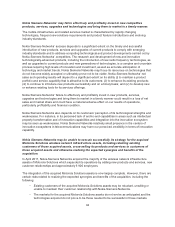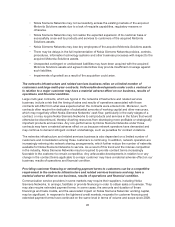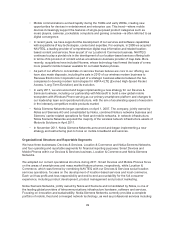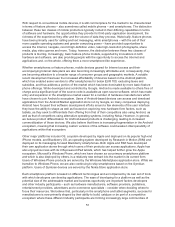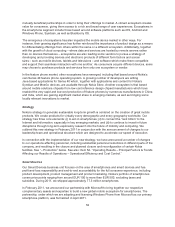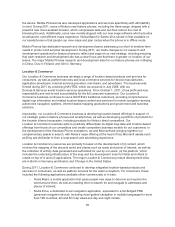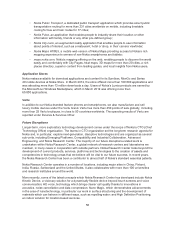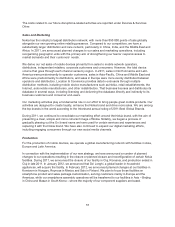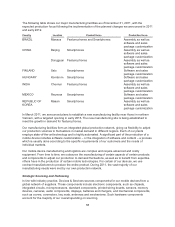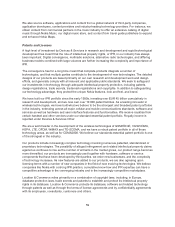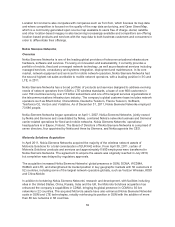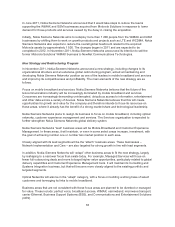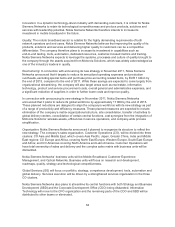Nokia 2011 Annual Report Download - page 56
Download and view the complete annual report
Please find page 56 of the 2011 Nokia annual report below. You can navigate through the pages in the report by either clicking on the pages listed below, or by using the keyword search tool below to find specific information within the annual report.Smart Devices has dedicated research and development teams addressing our short to medium-term
needs in product development. To support the execution of our new strategy, we are working to ensure
that each of our research and development sites for our smartphones has a clear focus and that there
is greater co-location of our teams. The major Smart Devices R&D sites are in Beijing in China,
San Diego in the United States and in Salo, Tampere and Greater Helsinki in Finland. The majority of
the Windows Phones team, including most of our Windows Phone engineering team, is based at our
research and development sites in Finland.
Mobile Phones
Our Mobile Phones business unit focuses on the area of mass market feature phones and related
services and applications and has profit-and-loss responsibility and end-to-end accountability for the
full consumer experience, including development, management and marketing of feature phone
products, services and applications. Nokia’s portfolio of feature phones covers a wide range of price
points from the Nokia 100, our most affordable device which costs about EUR 20, excluding taxes and
subsidies, through to devices with more premium features costing upwards of EUR 100, excluding
taxes and subsidies. During 2011, we shipped approximately 339.8 million feature phones.
In Mobile Phones, we have renewed our strategy to focus on capturing volume and value growth by
leveraging our innovation and strength in growth markets to provide people with an affordable Internet
experience on their mobile device – in many cases, their first ever Internet experience with any
computing device. Almost 90% of the world’s population lives within range of a mobile signal, yet there
are around three billion people who do not own a mobile device. Of those who do own a mobile device,
fewer than half use it to access the Internet for a number of reasons ranging from personal choice and
affordability to the lack of an available Internet connection. We recognize that there is a significant
opportunity to bring people everywhere affordable mobile products which enable simple and efficient
web browsing, as well as give access to maps and other applications and innovations.
While the broader mobile devices market has often been characterized in terms of smartphones and
feature phones, today, however, the distinction between these two classes of products is blurring.
Supported by technological and design innovations, Nokia’s portfolio of feature phones has over time
become smarter to the extent that today’s feature phone models are increasingly smartphone-like in
the functionality and experiences they provide. In the fourth quarter of 2011, we launched the Asha
range of Nokia feature phones, which offers access to the Internet, integrated social networking,
messaging and access to applications from Nokia Store.
The Nokia Asha 303, which began shipping in the fourth quarter 2011, is our most advanced feature
phone to date, combining a large 2.6" capacitive touch screen with a high quality QWERTY keypad,
featuring a 1Ghz engine, and supporting 3G and WLAN for a fast Internet experience. The Nokia Asha
303 retails for approximately EUR 115, excluding taxes and subsidies. The Nokia Asha 200, which also
launched in the fourth quarter 2011, features a full QWERTY keypad and stereo FM radio and offers
fast access to the Internet and applications in Nokia Store. It also features Nokia’s dual subscriber
identity module (“SIM”) technology, which enables users to simultaneously connect to two different
networks to receive calls and messages and to assign a name, logo and ringtone for up to five SIM
cards. This technology is particularly useful if the user wishes to easily and quickly take advantage of
more favorable tariffs offered by different operators at different times, switch SIMs when traveling, or to
keep personal and work connections separate. It also enables users to remove and insert SIMs in the
phone’s second SIM slot without turning off the phone. The Nokia Asha 200 was among seven dual
SIM devices we launched during 2011.
Nokia’s dual SIM technology was among several new innovations during 2011 aimed at increasing
affordability for the consumer not just at the point of sale, but in terms of the total cost of ownership of
54


